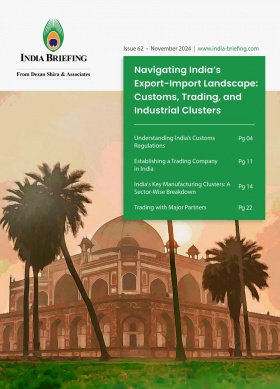India-U.S. Trade & Investment Flows: From Trump 1.0 to Biden
India and the United States share a strong and evolving trade partnership, marked by significant growth in exports and imports. The U.S. is a key market for Indian goods and services, while India is an increasingly important destination for American products. Despite occasional fluctuations, the trade relationship remains resilient, driven by complementary economic interests and shared strategic goals.
Over the past decade, India-U.S. trade and investment relations have evolved significantly, shaped by challenges and opportunities. This shift reflects a transition from the protectionist policies of the Trump administration (2017–2021) to the Biden administration’s focus on multilateralism and strategic partnerships (2021–2025).
The U.S. has emerged as India’s largest market for merchandise and services trade, with bilateral cooperation spanning critical sectors, such as technology, innovation, agriculture, clean energy, cyber sciences, telecommunications, health security, and space exploration. A major milestone in their bilateral economic engagement was the resolution of seven longstanding WTO disputes in 2022, which fostered smoother trade relations. Additionally, U.S. foreign direct investment (FDI) in India reached US$51.6 billion that year, reflecting an expansion of business and commercial ties. India’s elevation to Strategic Trade Authorization Tier 1 status in 2018 further facilitated license-free access to U.S.-regulated technologies, driving innovation and economic collaboration.
U.S. outlook towards India under Trump 2.0: What to expect
As Trump begins a second term as the 47th President of the United States on January 20, 2025, his approach toward India is expected to build on the robust defense and economic ties established during his first tenure.
Reports indicate that Trump has expressed interest in visiting India and China shortly after assuming office, signaling a dual-track strategy aimed at engaging two of the world’s most influential economies. India remains central to these plans, with discussions of a visit to New Delhi or inviting Indian Prime Minister Narendra Modi to the White House. This shows the sustained focus on strengthening American defense and strategic partnerships with India.
However, Trump’s “America First” philosophy is likely to drive his push for greater trade concessions benefiting the U.S. His continued transactional approach suggests that issues related to tariffs and market access may persist, which in turn could impact India’s ambitions on achieving trade volume targets.
Trade flows between India and the U.S.
A closer examination of trade data from 2016-17 to 2023-24 provides insight into the trajectory of the Indo-U.S. trade partnership. Indian exports to the U.S. have exhibited an upward trend, rising from INR 422.12 billion (US$4.87 billion) in 2016-17 to a peak of INR 785.42 billion (US$9.07 billion) in 2022-23.
|
India’s Exports to the U.S. Year-on-Year |
|
|
Year |
Export value |
|
2016-17 |
42,212.27 |
|
2017-18 |
47,878.48 |
|
2018-19 |
52,406.27 |
|
2019-20 |
53,088.77 |
|
2020-21 |
51,623.14 |
|
2021-22 |
76,167.01 |
|
2022-23 |
78,542.60 |
|
2023-24 |
77,515.03 |
Source: Ministry of Commerce and Industry, GoI
This growth reflects the strengthening demand for Indian goods, including textiles, pharmaceuticals, and technology services. However, occasional setbacks, such as the export dip to INR 516.23 billion (US$5.96 billion) in 2020-21 during the COVID-19 pandemic, highlight the impact of global economic disruptions. The post-pandemic period saw a swift recovery, with exports rebounding sharply before registering a marginal decline to INR 775.15 billion (US$8.95 billion) in 2023-24, likely signaling the normalization of trade after a period of rapid growth.
|
India’s Top Principal Commodity Exports to the U.S. |
|||
|
Year |
Principal commodities (Top 3) |
Value in US$ million |
U.S. presidential administration |
|
2017-18 |
Pearls, precious and semi-precious stones |
7,698 |
Donald J. Trump
(January 2017 to January 2021)
|
|
Drug formulation and biologicals |
4,602 |
||
|
Petroleum products |
2576 |
||
|
2018-19 |
Pearls, precious and semi-precious stones |
8,461 |
|
|
Drug formulation and biologicals |
5,327 |
||
|
RMG cotton including accessories |
2,420 |
||
|
2019-20 |
Pearls, precious and semi-precious stones |
7,229 |
|
|
Drug formulation and biologicals |
6,256 |
||
|
Electrical machinery and equipment |
2,796 |
||
|
2020-21 |
Drug formulation and biologicals |
7,114 |
|
|
Pearls, precious and semi-precious stones |
6,642 |
||
|
Cotton fabrics, made up, etc. |
2,584 |
||
|
2021-22 |
Pearls, precious and semi-precious stones |
10,817 |
Joe Biden
(January 2021- January 2025) |
|
Drug formulation and biologicals |
6,399 |
||
|
Petroleum products |
5,073 |
||
|
2022-23 |
Pearls, precious and semi-precious stones |
9,204 |
|
|
Drug formulation and biologicals |
6,775 |
||
|
Petroleum products |
6,037 |
||
|
2023-24 |
Drug formulation and biologicals |
8,015 |
|
|
Pearls, precious and semi-precious stones |
6,577 |
||
|
Petroleum products |
5,830 |
||
|
2024-25* |
Drug formulation and biologicals |
5,827 |
|
|
Telecom instruments |
4,391 |
||
|
Pearls, precious and semi-precious stones |
3,936 |
||
Source: Ministry of Commerce and Industry, GoI
*The FY2024-25 is currently ongoing and will conclude on March 31, 2025. The final trade figures will be released by the Ministry of Commerce and Industry after the completion of the financial year.
Similarly, imports from the U.S. have demonstrated steady growth, increasing from INR 223.07 billion (US$2.57 billion) in 2016-17 to a high of INR 508.63 billion (US$5.87 billion) in 2022-23.
|
India’s Imports from the U.S. Year-on-Year |
|
|
Year |
Import value |
|
2016-17 |
22,307.44 |
|
2017-18 |
26,611.03 |
|
2018-19 |
35,549.48 |
|
2019-20 |
35,819.87 |
|
2020-21 |
28,888.10 |
|
2021-22 |
43,314.07 |
|
2022-23 |
50,863.87 |
|
2023-24 |
42,195.49 |
Source: Ministry of Commerce and Industry, GoI
This rise reflects India’s growing demand for American goods, including machinery, aircraft, technology products, and energy commodities like oil and natural gas. The sharp increase in imports from INR 288.88 billion (US$3.33 billion) in 2020-21 to INR 433.14 billion (US$5 billion) in 2021-22 aligns with India’s post-pandemic recovery and focus on industrial expansion. However, a decline to INR 421.95 billion (US$4.87 billion) in 2023-24 may indicate adjustments in energy prices, supply chain dynamics, or import strategies.
|
India’s Top Principal Commodity Imports from the U.S. |
|||
|
Year |
Principal commodities (Top 3) |
Value in US$ million |
U.S. presidential administration |
|
2017-18 |
Electrical machinery and equipment |
2,292 |
Donald J. Trump 1.0
(January 2017 to January 2021)
|
|
Gold |
2,100 |
||
|
Aircraft, spacecraft and parts |
2,050 |
||
|
2018-19 |
Pearls, precious and semi-precious stones |
5,604 |
|
|
Petroleum: Crude oil |
3,589 |
||
|
Gold |
2,217 |
||
|
2019-20 |
Petroleum: Crude oil |
4,892 |
|
|
Pearls, precious and semi-precious stones |
4,442 |
||
|
Electrical machinery and equipment |
2,652 |
||
|
2020-21 |
Petroleum: Crude oil |
5,373 |
|
|
Pearls, precious and semi-precious stones |
3,655 |
||
|
Petroleum products |
2,021 |
||
|
2021-22 |
Petroleum: Crude oil |
11,320 |
Joe Biden
(January 2021- January 2025) |
|
Pearls, precious and semi-precious stones |
5,772 |
||
|
Petroleum products |
2,703 |
||
|
2022-23 |
Petroleum: Crude oil |
10,182 |
|
|
Pearls, precious and semi-precious stones |
5,383 |
||
|
Coal, coke and briquettes |
3,765 |
||
|
2023-24 |
Petroleum: Crude oil |
5,026 |
|
|
Coal, coke and briquettes |
4,320 |
||
|
Pearls, precious and semi-precious stones |
3,537 |
||
|
2024-25* |
Petroleum: Crude oil |
4,120 |
|
|
Petroleum products |
2,920 |
||
|
Coal, coke and briquettes |
2,429 |
||
Source: Ministry of Commerce and Industry, GoI
The trade data illustrates a dynamic relationship, with Indian exports consistently surpassing imports, resulting in a trade surplus with the U.S.
While the Trump 1.0 administration emphasized reducing trade deficits and protecting domestic industries, the Biden administration focused on deepening partnerships in technology, renewable energy, and healthcare. Sectors such as pharmaceuticals, information technology, and defense have remained key drivers of the growing trade relationship.
Despite periodic disagreements over tariffs and market access, India has emerged as a critical partner for the U.S., both as a market for exports and as a source of high-quality goods and services. Indian IT services and software exports, in particular, have played a substantive role in shaping this partnership.
Investment patterns between India and the U.S.
The U.S. is one of the largest sources of FDI into India, with cumulative investments exceeding US$60 billion as of 2023. Key sectors attracting U.S. FDI in India include technology, e-commerce, renewable energy, and healthcare. The Biden administration’s focus on clean energy and India’s ambitious renewable energy targets catalyzed significant investments into solar, wind, and green hydrogen projects.
|
FDI Equity Inflows from the U.S. into India |
|
|
Investment period |
Value in US$ million |
|
April 1, 2017- March 31, 2018 |
2,095 |
|
April 1, 2018- March 31, 2019 |
3,139 |
|
April 1, 2019- March 31, 2020 |
4,223 |
|
April 1, 2020- March 31, 2021 |
13,823 |
|
April 1, 2021- March 31, 2022 |
10,549 |
|
April 1, 2022- March 31, 2023 |
6,044 |
|
April 1, 2023- March 31, 2024 |
4,998 |
Source: FDI Statistics, DPIIT, GoI
Moreover, U.S. companies have expanded their presence in India’s e-commerce and technology sectors, with major players like Amazon, Google, and Microsoft leading the way.
Some of the key sectors for U.S. investment in India are as follows:
- Technology and innovation: The tech sector continues to dominate U.S. investment flows, with a focus on AI, cloud computing, and cybersecurity. India’s burgeoning startup ecosystem provides fertile ground for venture capital and private equity investments.
- Renewable energy: Collaboration in solar power, wind energy, and electric vehicles align with the global shift towards sustainability. The U.S.-India Strategic Clean Energy Partnership is a cornerstone of this engagement.
- Healthcare and pharmaceuticals: India’s role as the “pharmacy of the world” has attracted significant U.S. investment in pharmaceutical manufacturing and research and development (R&D).
- Defense and aerospace: Enhanced defense cooperation has paved the way for investments in aerospace manufacturing and technology transfer.
- Consumer goods and retail: With a large consumer market whose spending power is steadily growing, U.S. companies in retail and consumer goods are exploring opportunities to expand their footprint in India.
Market exposure
The U.S. is increasingly considering India as a reliable alternative to diversify supply chains and reduce dependency on China. India’s large consumer base, growing middle class, and policy initiatives like “Make in India” and the Production-Linked Incentive (PLI) schemes further bolster its appeal to U.S. businesses. Additionally, the Biden administration’s Indo-Pacific strategy aligns closely with India’s own economic and geopolitical aspirations, offering new avenues for collaboration.
Tariffs as an ‘X’ factor
Tariffs have often been a sticking point in India-U.S. trade relations. Under Trump 1.0, the U.S. imposed higher tariffs on Indian steel and aluminum, prompting India to retaliate with tariffs on U.S. goods such as almonds and apples. While the Biden administration took a more measured approach, legacy issues around tariffs remain unresolved.
However, recent efforts to negotiate sector-specific trade agreements, including collaboration in critical and emerging technologies, offer hope for a more balanced trade regime. A reinstatement of India’s Generalized System of Preferences (GSP) benefits could also help mitigate tariff-related tensions.
Conclusion
The trajectory of India-U.S. trade and investment relations highlights a maturing partnership characterized by mutual interests and shared goals. While challenges such as tariff disputes and regulatory hurdles persist, the overarching trend is one of convergence and collaboration. By leveraging synergies in technology, sustainability, and innovation, both nations are poised to strengthen their economic ties in the coming years – regardless of who occupies the Oval Office.
(US$1 = INR 86.53)
About Us
India Briefing is one of five regional publications under the Asia Briefing brand. It is supported by Dezan Shira & Associates, a pan-Asia, multi-disciplinary professional services firm that assists foreign investors throughout Asia, including through offices in Delhi, Mumbai, and Bengaluru in India. Readers may write to india@dezshira.com for support on doing business in India. For a complimentary subscription to India Briefing’s content products, please click here.
Dezan Shira & Associates also maintains offices or has alliance partners assisting foreign investors in China, Hong Kong SAR, Dubai (UAE), Indonesia, Singapore, Vietnam, Philippines, Malaysia, Thailand, Bangladesh, Italy, Germany, the United States, and Australia.
- Previous Article M&A Due Diligence in India: Assessing Target Company Non-Compliance
- Next Article India-Belgium Bilateral Relations: New Areas of Focus








